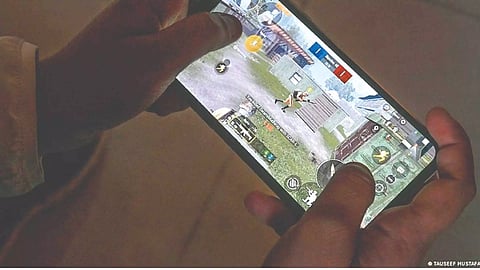

NIDHI SURESH
Sana (name changed), a 13-year-old gamer, said she was introduced to online gaming during the COVID pandemic. “Everyone had to do online classes and that got them closer to their phones, which meant more social media and gaming. That’s what happened to me as well,” she said. The online gaming industry has been booming in India in recent years. According to the State of India Gaming Report 2022, released by Lumikai, a gaming-focused venture capitalist fund, and Amazon Web Services, India currently is home to as many as 507 million gamers.
And the number of Indians getting into digital gaming is growing by 12% a year, given the country’s vast young population. Around 27.3% of the nation’s 1.4 billion people are aged between 15 and 29. About 43% of the gamers in India are female, the study said, adding that women and girls spent on average of close to 11.2 hours per week playing games, while men spent 10.2 hours.
Cheap and widespread access to smartphones and the internet has brought mobile games closer to India’s masses. Indians accessed more mobile games last year than people in any other country, notching up a combined 15 billion downloads. “The user base of the industry has peaked — people found that they could connect online, pass time and even make money sitting at home,” Zerah Gonsalves, one of India’s most well-known online gamers and a “shout-caster,” or anchor, for various gaming tournaments, told DW.
The gaming industry generated revenues worth $1.5 billion (1.4 billion euros) in 2022, and by 2025 that figure is expected to hit $5 billion. Khushveen Singh started gaming in school and has been an active player for more than 16 years. “My mother and I faced a lot of domestic violence at home and I battled depression as a child. For me, gaming has always been like therapy,” she said.
But many female gamers encounter abuse and threats online. Singh said in the gaming industry women have “always been treated inferior to the boys.”
“Even if we’re better than them, many times boys call out to us and ask us to go work in the kitchen instead of playing games,” she said. Singh also pointed out that sometimes if women are video streaming while playing, “boys shamelessly ask us to show our private parts and abuse us. This happens to almost every female streamer.” Sana said she has often encountered “paedophiles” while playing online games. She recounted making friends with a person online who soon “started asking personal questions” and spoke to her about how he was being “blamed for leaking the photos of women.”
Despite blocking him, he texted her from another account and sent obscene pictures, she said. Pointing to a culture of misogynistic behavior, Singh said, “I feel like they [males] do this because they’re not taught how to treat women properly in their households. I myself have experienced this in my family.” In addition to the abuse, female gamers confront widespread discrimination when it comes to prize money and brand sponsorships in esports, which refers to competitive gaming, where players train, win sponsorship deals and play in global tournaments.
According to the Esports Federation of India, women can win about $1,200 at a tournament, whereas open tournaments — which are dominated by male teams — offer prizes 100 times bigger.
This article was provided by Deutsche Welle